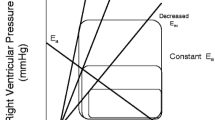Abstract
Using a rapid computerized thermodilution method, we examined the evolution of right ventricular performance in 23 patients with septic shock. Nine survived the episode of septic shock. The other 14 patients died of refractory circulatory shock. Significant right ventricular systolic dysfunction, defined as decreased ejection fraction (-39%) and right ventricular dilation (+38%) was observed in all patients with septic shock. However, in the survivors, increased right ventricular preload may prevent hemodynamic evidence of right ventricular pump failure by utilizing the Frank-Starling mechanism to maintain stroke volume. Conversely, in the nonsurvivors, right ventricular dysfunction was more prononced two days after the onset of septic shock, leading to a fall in stroke. In the last patients, a decrease in contractility appears to be the major factor accounting for decreased right ventricular performance, as evidenced by the marked increase in end-systolic volume (+27%) without significant change in pulmonary artery pressure, during the later stage of septic shock. The observed right ventricular pump failure then appears associated with an alteration in diastolic mechanical properties of this ventricle, as suggested by a leftward displacement of the individual pressure-volume curves.
Similar content being viewed by others
References
MacCabe WR, Kreger BE, Johns M (1972) Type specific and cross-reactive antibodies in gram negative bacteremia. N Engl J Med 287:261
Lefer AM (1970) Role of a myocardial depressant factor in the pathogenesis of circulatory shock. Fed Proc 29:1836
Carli A, Auclair MC, Bleichner G, Weber S, Lechat P, Monsallier JF (1978) Inhibited response to isoproterenol and altered action potential of beating rat heart cells by human serum in septic shock. Circ Shock 5:85
Parrillo JE, Burch C, Shelhamer JH, Parker MM, Natanson C, Schuette W (1985) A circulating myocardial depressant substance in humans with septic shock. J Clin Invest 76:1539
Siegel JH, Cerra FB, Coleman B, Giovannini I, Shedye M, Border JH, McMenamy RH (1979) Physiological and metabolic correlations in human sepsis. Surgery 86:163
Dhainaut JF, Huyghebaert MF, Monsallier JF, Lefevre G, Dall'Ava-Santucci, Brunet F, Villemant D, Carli A, Raichvarg D (1987) Coronary hemodynamics and myocardial metabolism of lactate, free fatty acids, glucose and ketones in human septic shock. Circulation 75:533
Cunnion RE, Schaer GL, Parker MM, Natanson C, Parrillo JE (1986) The coronary circulation in human septic shock. Circulation 73:637
Clowes GHA Jr, Farrington GH, Zuschneid W, Cossett GR, Saravis C (1970) Circulating factors in the etiology of pulmonary insufficiency and right heart failure accompanying severe sepsis (peritonitis). Ann Surg 171:663
Sibbald WJ, Paterson NAM, Holliday RL, Anderson RA, Lobb TR, Duff JH (1978) Pulmonary hypertension in sepsis. Chest 73:583
Hoffman MJ, Greenfield LJ, Sugerman HJ, Tatum JL (1983) Unsuspected RV dysfunction in shock and sepsis. Ann Surg 198:307
Kimchi A, Ellrodt AG, Berman DS, Riedinger MS, Swan HJC, Murata GH (1984) RV performance in septic shock: a combined radionuclide and hemodynamic study. J Am Coll Cardiol 4:945
Vincent JL, Thirion M, Brimioulle S, Lejeune P, Kahn RJ (1986) Thermodilution measurement of RV ejection fraction with a modified pulmonary artery catheter. Intensive Care Med 12:33
Dhainaut JF, Brunet F, Monsallier JF, Villemant D, Devaux JY, Konno M, de Gournay JM, Armaganidis A, Iotti G, Huyghbaert MF, Lanore JJ (1987) Bedside evaluation of RV performance using a rapid computerized thermodilution method. Crit Care Med 15:148
Dhainaut JF, Brunet F, Villemant D, de Gournay JM, Huyghebaert MF, Armaganidis A, Monsallier JF (1986) Amélioration de l'exactitude de la mesure de la fraction d'éjection ventriculaire droite par thermodilution. Réan Soins Intens Méd Urg 2:257 (Abstr)
Sibbald WJ, Driedger AA (1983) RV function in acute disease states: pathophysiologic considerations. Crit Care Med 11:339
Dhainaut JF, Devaux JY, Brunet F, Huyghebaert MF, Villemant D, de Gournay JM, Armaganidis A, Monsallier JF (1986) Evolution de la performance biventriculaire des patients atteints de SDRA. Réan Soins Intens Méd Urg 2:241 (Abstr)
Schneider AJ, Teule GJJ, Kester ADM, Heidendal GAK, Thijs LG (1986) Biventricular function during volume loading in porcine E. coli septic shock, with emphasis on RV function. Circ Shock 18:53
Parker MP, Shelhamer JH, Bacharach SL, Green MV, Natanson C, Frederick TM, Damske BA, Parrillo JE (1984) Profound but reversible myocardial depression in patients with septic shock. Ann Intern Med 100:483
Guyton AC, Lindsey AW, Gilluly JJ (1954) The limits of RV compensation following acute increases in pulmonary circulatory resistance. Circ Res 2:326
Author information
Authors and Affiliations
Rights and permissions
About this article
Cite this article
Dhainaut, J.F., Lanore, J.J., de Gournay, J.M. et al. Right ventricular dysfunction in patients with septic shock. Intensive Care Med 14 (Suppl 1), 488–491 (1988). https://doi.org/10.1007/BF00256967
Issue Date:
DOI: https://doi.org/10.1007/BF00256967




